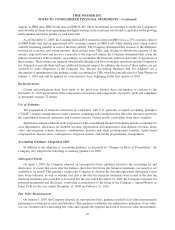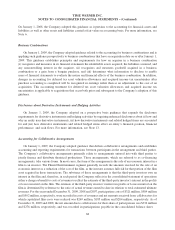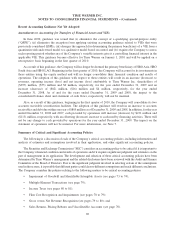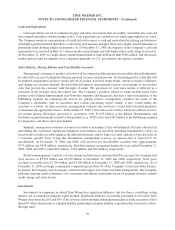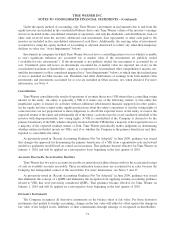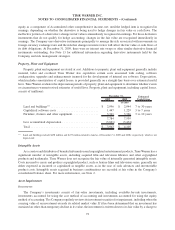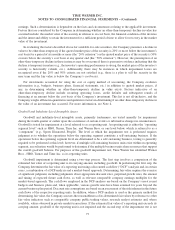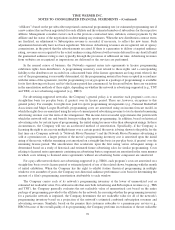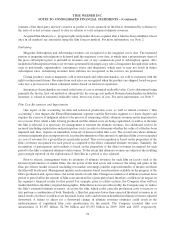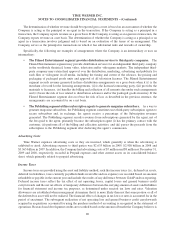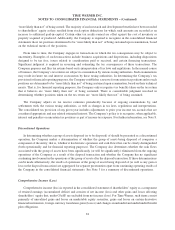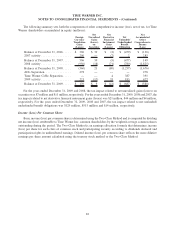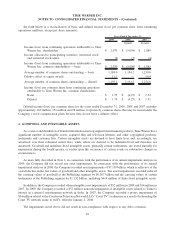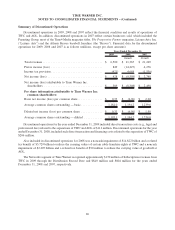Time Magazine 2009 Annual Report Download - page 88
Download and view the complete annual report
Please find page 88 of the 2009 Time Magazine annual report below. You can navigate through the pages in the report by either clicking on the pages listed below, or by using the keyword search tool below to find specific information within the annual report.“affiliates”) based on the per subscriber negotiated contractual programming rate (or estimated programming rate if
a new contract has not been negotiated) for each affiliate and the estimated number of subscribers for the respective
affiliate. Management considers factors such as the previous contractual rates, inflation, current payments by the
affiliate and the status of the negotiations in determining any estimates. When the new distribution contract terms
are finalized, an adjustment to Subscription revenue is recorded, if necessary, to reflect the new terms. Such
adjustments historically have not been significant. Television Advertising revenues are recognized, net of agency
commissions, in the period that the advertisements are aired. If there is a guarantee to deliver a targeted audience
rating, revenues are recognized for the actual audience rating delivered with revenue deferred for any shortfall until
the guaranteed audience rating is met, typically through the provision of additional air time. Advertising revenues
from websites are recognized as impressions are delivered or the services are performed.
In the normal course of business, the Networks segment enters into agreements to license programming
exhibition rights from distributors. A programming inventory asset related to these rights and a corresponding
liability to the distributor are recorded (on a discounted basis if the license agreements are long-term) when (i) the
cost of the programming is reasonably determined, (ii) the programming material has been accepted in accordance
with the terms of the agreement, (iii) the programming (or any program in a package of programming) is available
for its first showing or telecast, and (iv) the license period has commenced. As discussed below, there are variations
in the amortization methods of these rights, depending on whether the network is advertising-supported (e.g., TNT
and TBS) or not advertising-supported (e.g., HBO).
For advertising-supported networks, the Company’s general policy is to amortize each program’s costs on a
straight-line basis (or per-play basis, if greater) over its license period. There are, however, exceptions to this
general policy. For example, for rights fees paid for sports programming arrangements (e.g., National Basketball
Association and Major League Baseball), programming costs are amortized using an income-forecast model, in
which the rights fees are amortized using the ratio of current period advertising revenue to total estimated remaining
advertising revenue over the term of the arrangement. The income-forecast model approximates the pattern with
which the network will use and benefit from providing the sports programming. In addition, based on historical
advertising sales for certain types of programming, the initial airing has more value than subsequent airings. In these
circumstances, the Company will use an accelerated method of amortization. Specifically, if the Company is
licensing the right to air a movie multiple times over a certain period, the movie is being shown to the public for the
first time on a Company network (a “Network Movie Premiere”) and the Network Movie Premiere advertising is
sold at a premium rate, a larger portion of the movie’s programming inventory cost is amortized upon the initial
airing of the movie, with the remaining cost amortized on a straight-line basis (or per-play basis, if greater) over the
remaining license period. The amortization that accelerates upon the first airing versus subsequent airings is
determined based on a study of historical and estimated future advertising sales for similar programming. Costs
relating to licensed series agreements containing an advertising barter component are amortized in the same manner
in which costs relating to licensed series agreements without an advertising barter component are amortized.
For a pay cable network that is not advertising-supported (e.g., HBO), each program’s costs are amortized on a
straight-line basis over its license period or estimated period of use of the related shows, beginning with the month
of initial exhibition. When the Company has the right to exhibit feature theatrical programming in multiple
windows over a number of years, the Company uses historical audience performance as its basis for determining the
amount of a film’s programming amortization attributable to each window.
The Company carries each of its network’s programming inventory at the lower of unamortized cost or
estimated net realizable value. For cable networks that earn both Advertising and Subscription revenues (e.g., TBS
and TNT), the Company generally evaluates the net realizable value of unamortized cost based on the entire
package of programming provided to the affiliates by the network. In assessing whether the programming inventory
for a particular network is impaired, the Company determines the net realizable value for all of the network’s
programming inventory based on a projection of the network’s estimated combined subscription revenues and
advertising revenues. Similarly, based on the premise that customers subscribe to a premium pay service (e.g.,
HBO) because of the overall quality of its programming, the Company performs its evaluation of the net realizable
76
TIME WARNER INC.
NOTES TO CONSOLIDATED FINANCIAL STATEMENTS – (Continued)



